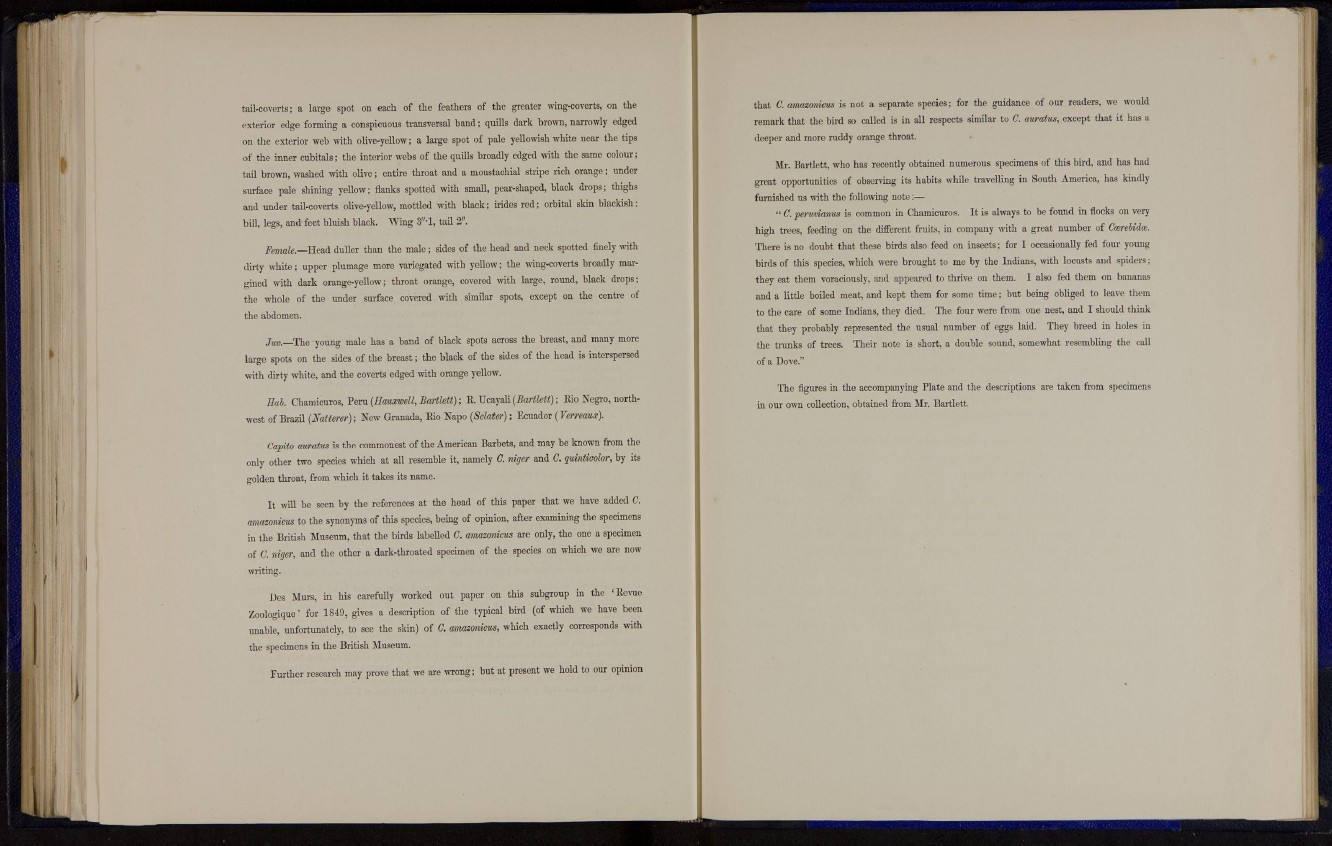
tail-coverts; a large spot on each of the feathers of the greater wing-coverts, on the
exterior edge forming a conspicuous transversal band; quills dark brown, narrowly edged
on the exterior web with olive-yellow; a large spot of pale yellowish white near the tips
of the inner cubitals; the interior webs of the quills broadly edged with the same colour ;
tail brown, washed with olive; entire throat and a moustachial stripe rich orange; under
surface pale shining yellow; flanks spotted with small, pear-shaped, black drops; thighs
and under tail-coverts olive-yellow, mottled with black; irides red; orbital skin blackish:
bill, legs, and feet bluish black. Wing 3"-l, tail 2".
Female.—Head duller than the male; sides of the head and neck spotted finely with
dirty white; upper plumage more variegated with yellow; the wing-coverts broadly margined
with dark orange-yellow; throat orange, covered with large, round, black drops;
t h e whole of the under surface covered with similar spots, except on the centre of
the abdomen.
Juv.—The young male has a band of black spots across the breast, and many more
large spots on the sides of the breast; the black of the sides of the head is interspersed
with dirty white, and t h e coverts edged with orange yellow.
Hub. Chamicuros, Peru (Hauxwell, Bartlett); E. Ucayali (Bartlett); Rio Negro, northwest
of Brazil (Natterer); New Granada, Rio Napo (Sclater); Ecuador (V e r r e a u x ).
Capito auratus is t h e commonest of t h e American Barbets, and may be known from the
only other two species which at all resemble it, namely C. niger and C. quinticolor, by its
golden throat, from which it takes its name.
I t will be seen by the references at the head of this paper that we have added C.
amazonicus to the synonyms of this species, being of opinion, after examining the specimens
in the British Museum, that the birds labelled C. amazonicus are only, the one a specimen
of C. niger, and the other a dark-throated specimen of the species on which we are now
writing.
Des Murs, in his carefully worked out paper on this subgroup in the ' Revue
Zoologique' for 1849, gives a description of the typical bird (of which we have been
unable, unfortunately, to sec the skin) of C. amazonicus, which exactly corresponds with
the specimens in the British Museum.
Further research may prove that we are wrong; but at present we hold to our opinion
that C. amazonicus is not a separate species; for the guidance of our readers, we would
remark that the bird so called is in all respects similar to C. auratus, except that it has a
deeper and more ruddy orange throat.
Mr. Bartlett, who has recently obtained numerous specimens of this bird, and has had
great opportunities of observing its habits while travelling in South America, has kindly
furnished us with the following n o t e :—
" C. peruvianus is common in Chamicuros. It is always to be found in flocks on very
high trees, feeding on the different fruits, in company with a great number of Casrebida.
There is no doubt that these birds also feed on insects; for I occasionally fed four young
birds of this species, which were brought to me by the Indians, with locusts and spiders;
they eat them voraciously, and appeared to thrive on them. I also fed them on bananas
and a little boiled meat, and kept them for some time; but being obliged to leave them
to the care of some Indians, they died. The four were from one nest, and I should think
that they probably represented the usual number of eggs laid. They breed in holes in
the trunks of trees. Their note is short, a double sound, somewhat resembling the call
of a Dove."
The figures in the accompanying Plate and the descriptions are taken from specimens
in our own collection, obtained from Mr. Bartlett.